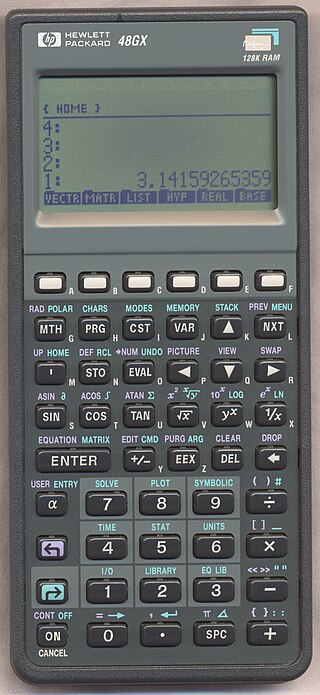In computing, source code, or simply code, is any collection of text, with or without comments, written using a human-readable programming language, usually as plain text. The source code of a program is specially designed to facilitate the work of computer programmers, who specify the actions to be performed by a computer mostly by writing source code.
AOLserver is AOL's open source web server. AOLserver is multithreaded, Tcl-enabled, and used for large scale, dynamic web sites.

The HP 48 is a series of graphing calculators designed and produced by Hewlett-Packard from 1990 until 2003. The series includes the HP 48S, HP 48SX, HP 48G, HP 48GX, and HP 48G+, the G models being expanded and improved versions of the S models. The models with an X suffix are expandable via special RAM and ROM cards. In particular, the GX models have more onboard memory than the G models. The G+ models have more onboard memory only. The SX and S models have the same amount of onboard memory.

The HP 49/50 series are Hewlett-Packard (HP) manufactured graphing calculators. They are the successors of the popular HP 48 series.
Plessey System 250, also known as PP250, was the first operational computer to implement capability-based addressing, to check and balance the computation as a pure Church–Turing machine. Plessey built the systems for a British Army message routing project.
The Plessey Company plc was a British electronics, defence and telecommunications company. It originated in 1917, growing and diversifying into electronics. It expanded after World War II by acquisition of companies and formed overseas companies.

IDEF, initially an abbreviation of ICAM Definition and renamed in 1999 as Integration Definition, is a family of modeling languages in the field of systems and software engineering. They cover a wide range of uses from functional modeling to data, simulation, object-oriented analysis and design, and knowledge acquisition. These definition languages were developed under funding from U.S. Air Force and, although still most commonly used by them and other military and United States Department of Defense (DoD) agencies, are in the public domain.
An application program is a computer program designed to carry out a specific task other than one relating to the operation of the computer itself, typically to be used by end-users. Word processors, media players, and accounting software are examples. The collective noun "application software" refers to all applications collectively. The other principal classifications of software are system software, relating to the operation of the computer, and utility software ("utilities").
The Pick Operating System is a demand-paged, multi-user, virtual memory, time-sharing computer operating system based around a MultiValue database. Pick is used primarily for business data processing. It is named after one of its developers, Dick Pick.

The Cambridge CAP computer was the first successful experimental computer that demonstrated the use of security capabilities, both in hardware and software. It was developed at the University of Cambridge Computer Laboratory in the 1970s. Unlike most research machines of the time, it was also a useful service machine.

The Decca Radar company was a British manufacturer of radar systems. There were originally two divisions, Marine and Heavy Radar, with separate product lines. The latter was sold to Plessey in 1965, and the term "Decca Radar" normally refers to the Marine division. That division remained with Decca until 1979 when it purchased by Racal to form Racal-Decca. After a series of further mergers and purchases, from 2000 the division is part of Northrop Grumman.

LAMP is an acronym denoting one of the most common software stacks for many of the web's most popular applications. However, LAMP now refers to a generic software stack model and its components are largely interchangeable.
Filetab is a decision table-based computer programming language widely used in business in the 1960s and 1970s.

A barcode system is a network of hardware and software, consisting primarily of mobile computers, printers, handheld scanners, infrastructure, and supporting software. Barcode systems are used to automate data collection where hand recording is neither timely nor cost effective. Despite often being provided by the same company, Barcoding systems are not radio-frequency identification (RFID) systems. Many companies use both technologies as part of larger resource management systems.

LYME and LYCE are software stacks composed entirely of free and open-source software to build high-availability heavy duty dynamic web pages. The stacks are composed of:
The following outline is provided as an overview of and topical guide to the Perl programming language:

RIOT is a small operating system for networked, memory-constrained systems with a focus on low-power wireless Internet of things (IoT) devices. It is open-source software, released under the GNU Lesser General Public License (LGPL).
Google Kythe is a source code indexer and cross-referencer for code comprehension which describes itself as a "pluggable, (mostly) language-agnostic ecosystem for building tools that work with code".








